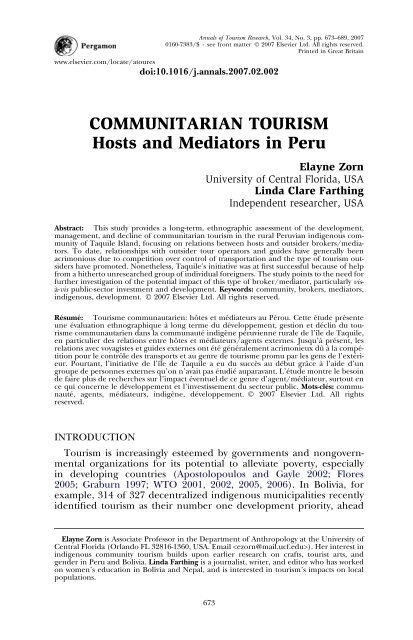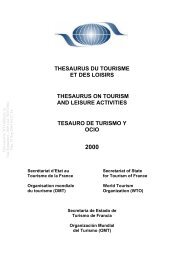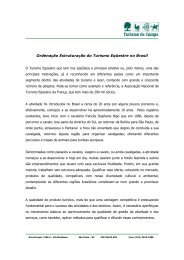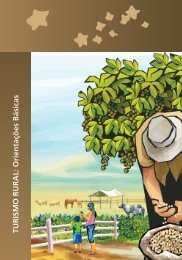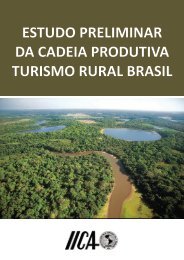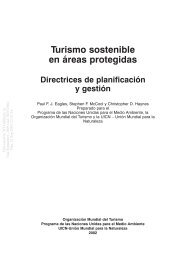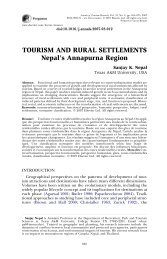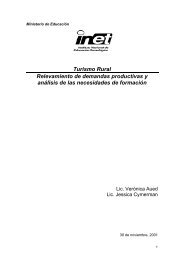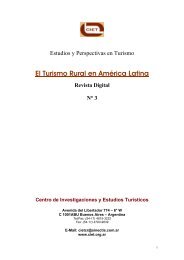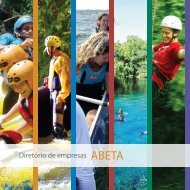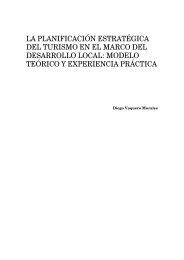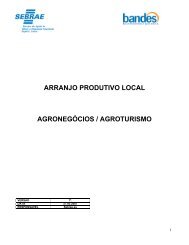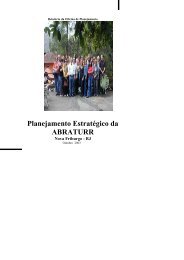COMMUNITARIAN TOURISM Hosts and Mediators in Peru
COMMUNITARIAN TOURISM Hosts and Mediators in Peru
COMMUNITARIAN TOURISM Hosts and Mediators in Peru
You also want an ePaper? Increase the reach of your titles
YUMPU automatically turns print PDFs into web optimized ePapers that Google loves.
Annals of Tourism Research, Vol. 34, No. 3, pp. 673–689, 2007<br />
0160-7383/$ - see front matter Ó 2007 Elsevier Ltd. All rights reserved.<br />
Pr<strong>in</strong>ted <strong>in</strong> Great Brita<strong>in</strong><br />
www.elsevier.com/locate/atoures<br />
doi:10.1016/j.annals.2007.02.002<br />
<strong>COMMUNITARIAN</strong> <strong>TOURISM</strong><br />
<strong>Hosts</strong> <strong>and</strong> <strong>Mediators</strong> <strong>in</strong> <strong>Peru</strong><br />
Elayne Zorn<br />
University of Central Florida, USA<br />
L<strong>in</strong>da Clare Farth<strong>in</strong>g<br />
Independent researcher, USA<br />
Abstract: This study provides a long-term, ethnographic assessment of the development,<br />
management, <strong>and</strong> decl<strong>in</strong>e of communitarian tourism <strong>in</strong> the rural <strong>Peru</strong>vian <strong>in</strong>digenous community<br />
of Taquile Isl<strong>and</strong>, focus<strong>in</strong>g on relations between hosts <strong>and</strong> outsider brokers/mediators.<br />
To date, relationships with outsider tour operators <strong>and</strong> guides have generally been<br />
acrimonious due to competition over control of transportation <strong>and</strong> the type of tourism outsiders<br />
have promoted. Nonetheless, Taquile’s <strong>in</strong>itiative was at first successful because of help<br />
from a hitherto unresearched group of <strong>in</strong>dividual foreigners. The study po<strong>in</strong>ts to the need for<br />
further <strong>in</strong>vestigation of the potential impact of this type of broker/mediator, particularly visà-vis<br />
public-sector <strong>in</strong>vestment <strong>and</strong> development. Keywords: community, brokers, mediators,<br />
<strong>in</strong>digenous, development. Ó 2007 Elsevier Ltd. All rights reserved.<br />
Résumé: Tourisme communautarien: hôtes et médiateurs au Pérou. Cette étude présente<br />
une évaluation ethnographique à long terme du développement, gestion et décl<strong>in</strong> du tourisme<br />
communautarien dans la communauté <strong>in</strong>digène péruvienne rurale de l’île de Taquile,<br />
en particulier des relations entre hôtes et médiateurs/agents externes. Jusqu’à présent, les<br />
relations avec voyagistes et guides externes ont été généralement acrimonieux dû à la compétition<br />
pour le contrôle des transports et au genre de tourisme promu par les gens de l’extérieur.<br />
Pourtant, l’<strong>in</strong>itiative de l’île de Taquile a eu du succès au début grâce à l’aide d’un<br />
groupe de personnes externes qu’on n’avait pas étudié auparavant. L’étude montre le beso<strong>in</strong><br />
de faire plus de recherches sur l’impact éventuel de ce genre d’agent/médiateur, surtout en<br />
ce qui concerne le développement et l’<strong>in</strong>vestissement du secteur public. Mots-clés: communauté,<br />
agents, médiateurs, <strong>in</strong>digène, développement. Ó 2007 Elsevier Ltd. All rights<br />
reserved.<br />
INTRODUCTION<br />
Tourism is <strong>in</strong>creas<strong>in</strong>gly esteemed by governments <strong>and</strong> nongovernmental<br />
organizations for its potential to alleviate poverty, especially<br />
<strong>in</strong> develop<strong>in</strong>g countries (Apostolopoulos <strong>and</strong> Gayle 2002; Flores<br />
2005; Graburn 1997; WTO 2001, 2002, 2005, 2006). In Bolivia, for<br />
example, 314 of 327 decentralized <strong>in</strong>digenous municipalities recently<br />
identified tourism as their number one development priority, ahead<br />
Elayne Zorn is Associate Professor <strong>in</strong> the Department of Anthropology at the University of<br />
Central Florida (Orl<strong>and</strong>o FL 32816-1360, USA. Email ). Her <strong>in</strong>terest <strong>in</strong><br />
<strong>in</strong>digenous community tourism builds upon earlier research on crafts, tourist arts, <strong>and</strong><br />
gender <strong>in</strong> <strong>Peru</strong> <strong>and</strong> Bolivia. L<strong>in</strong>da Farth<strong>in</strong>g is a journalist, writer, <strong>and</strong> editor who has worked<br />
on women’s education <strong>in</strong> Bolivia <strong>and</strong> Nepal, <strong>and</strong> is <strong>in</strong>terested <strong>in</strong> tourism’s impacts on local<br />
populations.<br />
673
674 <strong>COMMUNITARIAN</strong> <strong>TOURISM</strong><br />
of the traditional productive activities of farm<strong>in</strong>g <strong>and</strong> ranch<strong>in</strong>g (Montes<br />
2005).<br />
This study exam<strong>in</strong>es an experience that several recently-developed<br />
Andean projects have attempted to replicate (Maldonado 2005). Taquile<br />
Isl<strong>and</strong>, a rural <strong>in</strong>digenous <strong>Peru</strong>vian community, is often considered<br />
a model for what has come to be called communitarian tourism<br />
<strong>in</strong> Lat<strong>in</strong> America: that is, a locally developed, owned, <strong>and</strong> managed<br />
enterprise with community-wide distribution of benefits (Bardales<br />
2004; Campbell 1999; Maldonado 2003, 2005, 2006). A long-term, ethnographic<br />
assessment (1976–2006) is used to describe tourism’s explosive<br />
growth on Taquile, <strong>and</strong> how isl<strong>and</strong>ers developed, managed, <strong>and</strong><br />
then lost control, giv<strong>in</strong>g particular emphasis to relations between hosts<br />
<strong>and</strong> outsider mediators. Local impacts widely appreciated by<br />
Taquileans have <strong>in</strong>cluded <strong>in</strong>creased <strong>in</strong>come, skills, <strong>and</strong> social status.<br />
Observers concur that success was due to strong local structures, community-wide<br />
benefits distribution, favorable legislation, NGO assistance<br />
(one small but important grant), public <strong>and</strong> private partnerships, early<br />
publicity, <strong>and</strong> relations with ‘‘outsiders’’ (Drumm, Moore, Soles,<br />
Patterson, <strong>and</strong> Terborgh 2004; Gascón 2005; Levi 2003; Mitchell <strong>and</strong><br />
Eagles 2001; Partridge <strong>and</strong> Uquillas with Johns 1996; Zorn 2004).<br />
However, while these <strong>and</strong> studies elsewhere <strong>in</strong> the world analyze project<br />
set-up, development, <strong>and</strong> management, they tend to overlook the<br />
impact when circumstances <strong>and</strong> conditions change, as well as how tourism<br />
develops <strong>in</strong> the absence of private <strong>and</strong> public sector <strong>in</strong>vestment<br />
<strong>and</strong> tra<strong>in</strong><strong>in</strong>g. Such analysis can only be achieved through the use of<br />
long-term <strong>and</strong> longitud<strong>in</strong>al studies which <strong>in</strong>volve repeated return visits<br />
(sometimes over decades). While these methodologies are widely used<br />
throughout the social sciences, they rema<strong>in</strong> relatively uncommon <strong>in</strong><br />
studies, <strong>in</strong> part because only a h<strong>and</strong>ful of communitarian tourism <strong>in</strong>itiatives<br />
have lasted more than a decade (Carlsen 1999; Getz 1994;<br />
Haley, Snaith, <strong>and</strong> Miller 2005; Harvey, Hunt, <strong>and</strong> Harris 1995; Kottak<br />
2006; Lee, Kim, <strong>and</strong> Kang 2003; Meisch 2002; Tucker 2003; Van de Ven<br />
<strong>and</strong> Huber 1995). This type of research allows for the observation of<br />
‘‘structural transformation [<strong>and</strong>] history’’ <strong>and</strong> illum<strong>in</strong>ates ‘‘many<br />
aspects of local change that have more global causes <strong>and</strong> implications’’<br />
(Kottak 2006:221–222). Without them, practitioners <strong>and</strong> academics<br />
alike cannot anticipate the factors that limit long-term benefits to<br />
low-<strong>in</strong>come communities.<br />
This study focuses on relationships between local community members<br />
<strong>and</strong> two dist<strong>in</strong>ct groups of non-tourist outsiders, who are frequently<br />
referred to <strong>in</strong> the literature as brokers or more recently as<br />
mediators. These are both those who sought to take control (tour operators<br />
<strong>and</strong> tour guides), <strong>and</strong> those who helped propel tourism by voluntarily<br />
assist<strong>in</strong>g community members. This latter group—what Burns<br />
(1993:20) calls a ‘‘help<strong>in</strong>g community’’ of brokers/mediators who<br />
here are called ‘‘ad hoc advocate mediators’’—has to date gone largely<br />
unconsidered. The use of the phrase ‘‘ad hoc’’ emphasizes that these<br />
actors have no clear-cut <strong>in</strong>stitutional m<strong>and</strong>ate to assist with tourism<br />
development.
ZORN AND FARTHING 675<br />
The role of such mediators may be more vital than often assumed,<br />
for <strong>in</strong> a study of 170 Lat<strong>in</strong> American communitarian tourism <strong>in</strong>itiatives,<br />
Maldonado (2005) found that as many as 80% of projects were selfdeveloped,<br />
without active participation by state or nongovernmental<br />
actors. This f<strong>in</strong>d<strong>in</strong>g confirms studies that criticize the cast<strong>in</strong>g of locals<br />
as passive (Doron 2005; Werner 2003), <strong>and</strong> speaks to the creativity,<br />
<strong>in</strong>vention, <strong>and</strong> active agency of local hosts <strong>in</strong> many contexts <strong>in</strong> mobiliz<strong>in</strong>g<br />
assistance from outsiders. More research is needed to exam<strong>in</strong>e the<br />
potential importance of ad hoc advocate mediators, particularly vis-à-vis<br />
public-sector <strong>in</strong>vestment <strong>and</strong> development. Zorn, dur<strong>in</strong>g the course of<br />
her textile studies <strong>and</strong> long-term relationships with people on Taquile,<br />
is part of this group, <strong>and</strong> thus <strong>in</strong> exam<strong>in</strong><strong>in</strong>g her role, this study is situated<br />
with<strong>in</strong> the tradition of applied or active anthropology (Bennett<br />
1996; Chambers 1987), as well as anthropological reflexivity (Marcus<br />
ed. 1992; Wolf 1992), where the role of ethnographers forms part of<br />
the study (Burns 1993; Wolf 1992).<br />
With<strong>in</strong> the anthropology of tourism, numerous studies beg<strong>in</strong>n<strong>in</strong>g<br />
with the widely-cited volume edited by Valerie Smith (1977), have<br />
exam<strong>in</strong>ed social actors as either ‘‘hosts’’ or ‘‘guests,’’ <strong>and</strong> this cont<strong>in</strong>ues<br />
to be a key rubric of analysis (Zorn 2004). Critiques of analyz<strong>in</strong>g<br />
these two categories alone have led to consideration of a third category<br />
of actors: those who serve as mediators between hosts <strong>and</strong> guests.<br />
Chambers describes their importance:<br />
Tourism is a highly mediated activity. It is mediated by... government<br />
officials, tourism planners, advertis<strong>in</strong>g <strong>and</strong> market<strong>in</strong>g agencies, associated<br />
‘‘hospitality’’ <strong>in</strong>dustries... travel agents <strong>and</strong> guides, travel writers<br />
<strong>and</strong> publishers, preservationists, <strong>and</strong> even by people who study<br />
tourism (2000:30, italics <strong>in</strong> orig<strong>in</strong>al).<br />
<strong>Mediators</strong> play structural roles similar to people described <strong>in</strong> the<br />
mid-20th century by sociologists as ‘‘marg<strong>in</strong>al men’’ (Press 1969) <strong>and</strong><br />
by anthropologists as ‘‘culture brokers’’ (Press 1969; E. Wolf 1956):<br />
those who mediate relations between groups of unequal social status.<br />
Marg<strong>in</strong>al men or culture brokers are characterized as mediators between<br />
their own group <strong>and</strong> the world outside, even <strong>in</strong> complex societies<br />
(Press 1969; E. Wolf 1956). In an early use of this concept <strong>in</strong> tourism<br />
studies, Cohen (1985) describes tour operators as ‘‘culture brokers’’,<br />
which Smith later def<strong>in</strong>ed as ‘‘the mediator between hosts <strong>and</strong> guests’’,<br />
situated between ‘‘the dem<strong>and</strong> <strong>and</strong> the supply sides of tourism’’<br />
(Smith 2001:276–277). For example, anthropologists are cultural brokers,<br />
because they mediate between the cultures they study <strong>and</strong> the<br />
audiences who read their ethnographies. Today, the term broker is<br />
more commonly applied to people who fulfill this role (Peace 1998).<br />
However, social-scientific research on mediators is still relatively<br />
undeveloped compared to the study of tourists <strong>and</strong> toured (Chambers<br />
1985, 1987; Evans 1981; <strong>and</strong> Jenn<strong>in</strong>gs <strong>and</strong> Weiler 2006). Werner sees<br />
mediators as agents of social change, describ<strong>in</strong>g them as ‘‘primary<br />
agents of tourism’’ (2003:145). Doron proposes study<strong>in</strong>g cultural brokers<br />
such as the boatmen of Varanasi to highlight the ‘‘creative<br />
<strong>and</strong> <strong>in</strong>novative practices of the host group’’ that otherwise might be
676 <strong>COMMUNITARIAN</strong> <strong>TOURISM</strong><br />
‘‘rendered <strong>in</strong>visible’’ (2005:157). Jenn<strong>in</strong>gs <strong>and</strong> Weiler provide a table<br />
of ‘‘mediators <strong>and</strong> brokers associated with the tourist experience’’ that<br />
lists ‘‘formal’’ <strong>and</strong> ‘‘<strong>in</strong>formal’’ mediators (2006:62), but the group of<br />
mediators under consideration here is not <strong>in</strong>cluded, even with<strong>in</strong> the<br />
broader def<strong>in</strong>ition they employ that <strong>in</strong>cludes ‘‘other tourists, tourist<br />
providers, governments, communities, <strong>and</strong> <strong>in</strong>digenous groups as well<br />
as other <strong>in</strong>terested <strong>and</strong> related organizations, agencies, <strong>and</strong> service<br />
providers’’ (Jenn<strong>in</strong>gs <strong>and</strong> Weiler 2006:57).<br />
This study draws on ethnographic fieldwork carried out over a 30-<br />
year period (1976–2006). As is common <strong>in</strong> ethnographic research,<br />
the longitud<strong>in</strong>al study was unplanned; thus, observation <strong>in</strong>tervals were<br />
irregular, as was the <strong>in</strong>tensity of observations. Dur<strong>in</strong>g <strong>in</strong>itial fieldwork<br />
on traditional textile production <strong>in</strong> 1976, ‘‘backpack<strong>in</strong>g’’ foreign hippie<br />
tourism to Taquile began, follow<strong>in</strong>g publication of a notice prais<strong>in</strong>g<br />
the isl<strong>and</strong> <strong>in</strong> the 1976 edition of the English-language travel guide, the<br />
South American H<strong>and</strong>book. Zorn documented this development, along<br />
with research on transformations <strong>in</strong> textiles for sale to the tourism market.<br />
Additional visits were made <strong>in</strong> 1983–84, 1986–89, 2002, 2005, <strong>and</strong><br />
2006; Zorn also worked as a translator/presenter for Taquilean groups<br />
at cultural events <strong>in</strong> the United States <strong>in</strong> 1991 <strong>and</strong> 1994, <strong>and</strong> ma<strong>in</strong>ta<strong>in</strong>ed<br />
periodic contact through telephone calls, letters, <strong>and</strong> more recently,<br />
email. Farth<strong>in</strong>g has visited the isl<strong>and</strong> briefly, <strong>and</strong> advised on<br />
attempts to establish communitarian tourism on the opposite side of<br />
Lake Titicaca <strong>in</strong> Bolivia.<br />
Research methodology <strong>in</strong>cluded ethnographic participant observation,<br />
apprenticeship <strong>in</strong> textile production, unstructured <strong>in</strong>terviews with<br />
community representatives <strong>and</strong> authorities (us<strong>in</strong>g network-based<br />
‘‘snowball’’ sampl<strong>in</strong>g), <strong>and</strong> semistructured <strong>and</strong> structured <strong>in</strong>terviews.<br />
Unstructured <strong>in</strong>terviews were conducted with tourists <strong>and</strong> tour agency<br />
operators <strong>and</strong> guides. In addition, community tourism records were<br />
exam<strong>in</strong>ed for several periods dur<strong>in</strong>g the 70s <strong>and</strong> 80s. Research was conducted<br />
<strong>in</strong> Quechua (the Inca language) <strong>and</strong> Spanish.<br />
HOSTS, GUESTS AND MEDIATORS<br />
The t<strong>in</strong>y isl<strong>and</strong> of Taquile (population 1,900 <strong>in</strong> 2005), located at<br />
13,000 feet above sea level on Lake Titicaca, is best known for the suddenness<br />
<strong>and</strong> success of the tourism its <strong>in</strong>digenous community developed<br />
dur<strong>in</strong>g the late 70s <strong>and</strong> 80s, without government or<br />
nongovernmental organization <strong>in</strong>tervention (Gartner <strong>and</strong> Morton<br />
2000; Gascón 2005; Healy <strong>and</strong> Zorn 1982–83; Mitchell <strong>and</strong> Reid<br />
2001; Prochaska 1990; Zorn 2004). Taquileans are low-<strong>in</strong>come peasant<br />
farmers, who grow potatoes, tubers, <strong>and</strong> other subsistence crops us<strong>in</strong>g<br />
ra<strong>in</strong>fall agriculture on their <strong>in</strong>tensively terraced isl<strong>and</strong>, <strong>and</strong> also fish<br />
from the lake. All isl<strong>and</strong>ers speak Quechua as their first language,<br />
<strong>and</strong> an <strong>in</strong>creas<strong>in</strong>g number also speak Spanish, though women <strong>in</strong> particular<br />
are likely to be monol<strong>in</strong>gual Quechua speakers. Literacy (only<br />
<strong>in</strong> Spanish) rema<strong>in</strong>s limited, though it is grow<strong>in</strong>g. Until tourism began,<br />
Taquile was extremely isolated, reachable only by reed boat. Beg<strong>in</strong>n<strong>in</strong>g
ZORN AND FARTHING 677<br />
<strong>in</strong> the late 60s, the isl<strong>and</strong> became known to some textile scholars <strong>and</strong><br />
collectors as a place to f<strong>in</strong>d some of the f<strong>in</strong>est h<strong>and</strong>weav<strong>in</strong>gs <strong>in</strong> <strong>Peru</strong>.<br />
Similar to many other Andean peasant communities, Taquile is organized<br />
on the basis of the pre-Columbian ayllu (corporate k<strong>in</strong>-group)<br />
system, which regulates crop rotation <strong>and</strong> governs through a dual set<br />
of authorities, both ‘‘traditional’’ <strong>and</strong> those l<strong>in</strong>ked to the national government.<br />
Community decisionmak<strong>in</strong>g is participative; service is voluntary<br />
<strong>and</strong> rotative. Though all Taquileans are peasants, social strata exist<br />
with<strong>in</strong> the community. In the early 50s, Taquileans characterized these<br />
groups as ‘‘powerful,’’ ‘‘just enough’’ <strong>and</strong> ‘‘poor,’’ based on their access<br />
to l<strong>and</strong> (Avalos de Matos 1951; Matos 1951).<br />
Taquile is one of few communities <strong>in</strong> <strong>Peru</strong> today where all residents<br />
cont<strong>in</strong>ue to create textiles <strong>and</strong> wear traditional dress on a daily basis.<br />
Cloth was the pre-em<strong>in</strong>ent Andean cultural product for more than<br />
3,000 years, <strong>and</strong> <strong>in</strong> this region, women create the most important<br />
textiles (Zorn <strong>and</strong> Quispe 2004). The sale of h<strong>and</strong>made textiles is an<br />
important secondary <strong>in</strong>come-generat<strong>in</strong>g activity, <strong>and</strong> textiles are a<br />
commonly-sought tourist souvenir (Meisch 2002). Taquile appears as<br />
the essence of Indian <strong>Peru</strong>: Quechua-speak<strong>in</strong>g potato farmers,<br />
wear<strong>in</strong>g beautiful cloth<strong>in</strong>g, set high <strong>in</strong> the Andes mounta<strong>in</strong>s surrounded<br />
by a spectacular lake, with adobe brick homes, <strong>and</strong> few modern<br />
conveniences.<br />
Dur<strong>in</strong>g the 20th century, Taquileans were conservative <strong>in</strong> many ways,<br />
but <strong>in</strong>novative <strong>in</strong> others. They reta<strong>in</strong>ed many traditional cultural practices<br />
<strong>and</strong> were late to build wooden sailboats, but made alliances with<br />
outsiders that would prove key <strong>in</strong> attract<strong>in</strong>g tourists. In the 30s, far <strong>in</strong><br />
advance of other nearby peasant communities, one of the wealthier<br />
<strong>in</strong>digenous men, assisted f<strong>in</strong>ancially by five other families, <strong>in</strong>itiated a<br />
long court battle to purchase l<strong>and</strong> from non-<strong>in</strong>digenous l<strong>and</strong>owners<br />
(Matos 1951, 1986). After 20 years of harassment, <strong>and</strong> persecution,<br />
the Taquileans were successful, but community pressure forced the<br />
wealthier families to sell some of the acquired l<strong>and</strong> to their poorer relatives<br />
(Matos 1986). S<strong>in</strong>ce they obta<strong>in</strong>ed title to the rema<strong>in</strong><strong>in</strong>g l<strong>and</strong> <strong>in</strong><br />
1970, the community has steadfastly resisted sell<strong>in</strong>g l<strong>and</strong> to outsiders,<br />
or even allow<strong>in</strong>g outsiders to rent or build.<br />
When Taquileans have not been able to resolve conflicts with outsiders,<br />
they have attempted to ‘‘go to the top.’’ A modest success occurred<br />
<strong>in</strong> 1931, when then-president (<strong>and</strong> former political prisoner on Taquile)<br />
Luís Sánchez Cerro ended obligatory unpaid personal service to<br />
the isl<strong>and</strong>’s l<strong>and</strong>owners—a form of peonage not abolished <strong>in</strong> the rest<br />
of <strong>Peru</strong> until 1968. This success illustrates how notionally ‘‘backward’’<br />
Taquileans discovered mechanisms to effect changes far <strong>in</strong> advance of<br />
their more ‘‘acculturated’’ brethren.<br />
Despite poor communications (no electricity, phone, or telegraph)<br />
<strong>and</strong> difficulty of access, Taquileans never cut themselves off from the<br />
outside world. The isl<strong>and</strong> has an elementary school <strong>and</strong> despite the<br />
complexities of reconcil<strong>in</strong>g school<strong>in</strong>g with peasant agricultural life,<br />
they repeatedly petitioned for a high school, which was f<strong>in</strong>ally built<br />
<strong>in</strong> the 90s. In the early 50s, a new generation of young entrepreneurial<br />
men rose to community power by a non-traditional route, which
678 <strong>COMMUNITARIAN</strong> <strong>TOURISM</strong><br />
<strong>in</strong>volved more extensive <strong>in</strong>teraction with outsiders <strong>and</strong> learn<strong>in</strong>g Spanish<br />
(Matos 1986). These elite, who were cultural brokers <strong>in</strong> the classic<br />
anthropological sense, subsequently exp<strong>and</strong>ed their <strong>in</strong>fluence through<br />
tourism (Zorn 2004), a result paralleled <strong>in</strong> Otavalo, Ecuador (Colloredo-Mansfield<br />
1999; Meisch 2002).<br />
In 1968, then-US-Peace-Corps volunteer Kev<strong>in</strong> Healy was liv<strong>in</strong>g nearby,<br />
<strong>and</strong> persuaded Taquileans to sell their textiles <strong>in</strong> a US-sponsored<br />
cooperative based <strong>in</strong> Cusco (Healy <strong>and</strong> Zorn 1982–1983, 1994). In<br />
the cash-poor Andes, this represented an unusual opportunity. Even<br />
today, older Taquileans recall that first sale as a stunn<strong>in</strong>g moment, when<br />
isl<strong>and</strong>ers realized they could earn money for someth<strong>in</strong>g that the outside<br />
world despised due to prevail<strong>in</strong>g national racism aga<strong>in</strong>st Indians.<br />
Although the Cusco cooperative collapsed <strong>in</strong> 1971, the experience<br />
propelled a h<strong>and</strong>ful of young Taquilean men to become textile merchants,<br />
sell<strong>in</strong>g their extended families’ fabrics to foreign exporters,<br />
scholars, <strong>and</strong> tourists <strong>in</strong> <strong>Peru</strong>vian cities. Aga<strong>in</strong>, a small number of them<br />
brokered relationships between the community <strong>and</strong> the outside world,<br />
generat<strong>in</strong>g cash <strong>in</strong>come that, albeit modest, was significant given previous<br />
alternatives (Zorn 2004). Women began to earn money for the<br />
first time, caus<strong>in</strong>g shifts <strong>in</strong> gender relations. These <strong>in</strong>itial connections<br />
with the h<strong>and</strong>icraft market, as well as experience <strong>in</strong>teract<strong>in</strong>g with foreigners,<br />
proved crucial when tourism got underway several years later.<br />
Furthermore, the cash was critical <strong>in</strong> provid<strong>in</strong>g Taquileans money for<br />
capital <strong>in</strong>vestments.<br />
Taquile’s isolated <strong>and</strong> poor <strong>in</strong>habitants were not obvious c<strong>and</strong>idates<br />
for success with young backpackers. However, when <strong>in</strong>ternational tourism<br />
to <strong>Peru</strong> nearly tripled dur<strong>in</strong>g the 70s, a few hardy foreigners braved<br />
the 12+ hour sailboat voyage to visit the isl<strong>and</strong> (Gascón 2005:51–52).<br />
From the beg<strong>in</strong>n<strong>in</strong>g, the length of the trip required an overnight stay,<br />
<strong>and</strong> visitors were housed <strong>in</strong> the homes of government authorities or<br />
textile merchants. With<strong>in</strong> a year, Taquileans (mostly <strong>in</strong> exist<strong>in</strong>g sailboat<br />
cooperatives) pooled their textile sav<strong>in</strong>gs <strong>and</strong> bought second- <strong>and</strong><br />
third-h<strong>and</strong> truck eng<strong>in</strong>es. With motors, travel time dropped to three<strong>and</strong>-a-half<br />
hours, <strong>and</strong> tourist traffic accelerated. In early 1978, with a<br />
modest grant from the US Inter-American Foundation, Taquileans<br />
formed motorboat cooperatives, as groups of 20 to 40 families ordered<br />
safer, larger, <strong>and</strong> more attractive vessels from local boatwrights. Eventually,<br />
the isl<strong>and</strong>ers displaced boat owners from the ma<strong>in</strong>l<strong>and</strong> city of<br />
Puno who had previously brought most of the tourists to the isl<strong>and</strong>,<br />
<strong>and</strong> successfully petitioned for a government-sanctioned monopoly.<br />
By 1982, the cooperative transport groups had exp<strong>and</strong>ed to 13, <strong>and</strong><br />
nearly every family had at least one member <strong>in</strong> a boat group.<br />
Taquileans created various community <strong>and</strong> family-based bus<strong>in</strong>esses,<br />
<strong>in</strong>clud<strong>in</strong>g a billet<strong>in</strong>g system offer<strong>in</strong>g overnight stays <strong>in</strong> local homes, a<br />
crafts cooperative/store where all isl<strong>and</strong>ers could sell textiles, <strong>in</strong>dividual-<br />
<strong>and</strong> family-owned restaurants, <strong>and</strong> a rustic museum. With the<br />
exception of the grant, Taquileans, who had virtually no access to bank<br />
or personal loans, assumed all the associated costs <strong>and</strong> risks without<br />
assum<strong>in</strong>g any debt. In 1978, 68 families were authorized to take <strong>in</strong> overnight<br />
foreign guests. By August 1982, the number had risen to 207, or
ZORN AND FARTHING 679<br />
nearly every family on the isl<strong>and</strong>. Growth was rapid: community records<br />
show 5,300 foreign tourists visited Taquile between January-August<br />
1982, <strong>and</strong> most stayed for two to three days.<br />
To manage their new enterprise, Taquileans drew on long-st<strong>and</strong><strong>in</strong>g<br />
practices of cooperation, some pre-conquest <strong>in</strong> orig<strong>in</strong>. Tourism committee<br />
<strong>and</strong> subcommittees were <strong>in</strong> charge, with construction <strong>and</strong> ma<strong>in</strong>tenance<br />
the responsibility of traditional community-wide volunteer<br />
work parties. They learned to operate <strong>and</strong> then build boats, established<br />
<strong>and</strong> ma<strong>in</strong>ta<strong>in</strong>ed lodg<strong>in</strong>g st<strong>and</strong>ards, encouraged isl<strong>and</strong>ers to sell crafts<br />
through the store rather than at home, <strong>and</strong> resolved conflicts over<br />
the disposition of <strong>in</strong>creased <strong>in</strong>come.<br />
This ‘‘ethnotouristic community’’ (Grünewald 2006:7) <strong>in</strong>cluded<br />
important relationships with ad hoc advocate mediators who over the<br />
course of several decades voluntarily assisted community members by<br />
broker<strong>in</strong>g relationships with outsiders of higher social status. They provided<br />
advice, expertise <strong>in</strong> grant-writ<strong>in</strong>g <strong>and</strong> <strong>in</strong>formation about tourists,<br />
as well as advocacy <strong>in</strong> the face of government bureaucracy <strong>and</strong> conflicts<br />
with tour operators. The majority were students (of anthropology primarily),<br />
<strong>and</strong> were, almost without exception, foreigners, <strong>and</strong> this characteristic<br />
reveals an ethnic dimension to mediation that to date has<br />
received little attention <strong>in</strong> the literature.<br />
In addition, they had no local family or bus<strong>in</strong>ess l<strong>in</strong>ks, but community<br />
members frequently cemented ties with them through the wellknown<br />
<strong>in</strong>stitution of compadrazgo, or godparenthood (also known as<br />
spiritual or ritual k<strong>in</strong>ship), <strong>in</strong> which a relationship is formalized between<br />
the child’s parents <strong>and</strong> new ‘‘co-parents.’’ This <strong>in</strong>stitution can<br />
l<strong>in</strong>k either social equals or people of different social groups (M<strong>in</strong>tz<br />
<strong>and</strong> Wolf 1950). Although the practice is based on Catholic baptism,<br />
almost without exception <strong>in</strong> Taquile the ceremony was performed at<br />
home dur<strong>in</strong>g the pre-conquest ritual of first rutuchiy (haircutt<strong>in</strong>g),<br />
which native Andeans have adapted <strong>in</strong>to a variant of godparenthood.<br />
This facilitated compadrazgo’s use <strong>in</strong> circumstances where there is no<br />
resident priest or where the godparent is not Catholic, both obvious<br />
advantages <strong>in</strong> situations <strong>in</strong>volv<strong>in</strong>g foreigners.<br />
Dur<strong>in</strong>g the 70s, key ad hoc advocate mediators such as Belgian priest<br />
Padre ‘‘Pepe’’ Loits <strong>and</strong> Peace Corps volunteer Kev<strong>in</strong> Healy, <strong>and</strong> key<br />
Taquileans, particularly Francisco ‘‘Pancho’’ Huatta, ‘‘persuaded<br />
(Taquile) residents of tourism’s economic advantages’’ (Mitchell <strong>and</strong><br />
Reid 2001:123). Padre Loits, who was <strong>in</strong> the Catholic church parish<br />
<strong>in</strong> nearby Capachica, was one of the few non-Taquileans to regularly<br />
visit the isl<strong>and</strong>, where he performed marriages <strong>and</strong> other rites. Francisco<br />
Huatta was one of the first textile sellers, develop<strong>in</strong>g long-term<br />
contacts with buyers <strong>in</strong> several <strong>Peru</strong>vian cities, <strong>and</strong> later serv<strong>in</strong>g as a<br />
community leader <strong>in</strong> tourism projects. Zorn, like many other anthropologists<br />
who become advocates for the people they study (Bennett<br />
1996; Burns 1993), helped the community write the Inter-American<br />
Foundation grant application <strong>and</strong> assisted the community <strong>in</strong> mediat<strong>in</strong>g<br />
relations with banks <strong>in</strong> Puno, <strong>Peru</strong>vian educational authorities,<br />
<strong>and</strong> museums <strong>in</strong> the United States. She became a godparent of one<br />
of Huatta’s children.
680 <strong>COMMUNITARIAN</strong> <strong>TOURISM</strong><br />
Other ad hoc advocate mediators <strong>in</strong>cluded a German expatriate textile<br />
scholar <strong>and</strong> exporter (Gertrudis de Solari) who was the first person<br />
to buy textiles <strong>in</strong> quantity; an English importer (Moh F<strong>in</strong>i) who sponsored<br />
the first trip abroad of a Taquilean (F<strong>in</strong>i 1985); a French ethnomusicologist,<br />
a German anthropology student study<strong>in</strong>g <strong>in</strong> the United<br />
States (Prochaska 1990), <strong>and</strong> a Japanese doctor who lived on the isl<strong>and</strong><br />
for a year. Accord<strong>in</strong>g to Taquileans, only two were <strong>Peru</strong>vians (one an<br />
anthropologist <strong>and</strong> the other a tourism authority). This preponderance<br />
of non-<strong>Peru</strong>vians is expla<strong>in</strong>ed, accord<strong>in</strong>g to isl<strong>and</strong>ers, by the <strong>in</strong>tense<br />
racism they suffer from non-<strong>in</strong>digenous people <strong>in</strong> highly<br />
exclusionary <strong>Peru</strong>vian society.<br />
While growth was propelled by ‘‘outsiders,’’ it has, <strong>in</strong> significant<br />
ways, been built on Taquile’s strong communal spirit <strong>and</strong> tradition<br />
of participation <strong>and</strong> management of resources. Community participation<br />
was key right from the beg<strong>in</strong>n<strong>in</strong>g, although nearly half the isl<strong>and</strong>ers<br />
cannot remember the <strong>in</strong>itial plan’s formulation <strong>in</strong> the 70s. Mitchell<br />
<strong>and</strong> Reid found that ‘‘Taquileans have a very high level of <strong>in</strong>dividual<br />
<strong>in</strong>volvement <strong>in</strong> tourism service adm<strong>in</strong>istration (79% of respondents)<br />
<strong>and</strong> community tourism meet<strong>in</strong>gs (96%)’’ (2001:125), though the<br />
authors noted that participation sometimes meant simple attendance<br />
rather than active engagement. Despite ongo<strong>in</strong>g factional <strong>and</strong> generational<br />
conflicts, the skill of isl<strong>and</strong>ers <strong>in</strong> unit<strong>in</strong>g as a community was central<br />
to their successes (MacDonald <strong>and</strong> Jolliffee 2003; Mitchell <strong>and</strong><br />
Reid 2001; Nyaupane, Morais, Dowler 2005; Zorn 2004). S<strong>in</strong>ce the early<br />
80s, outsiders have aggressively tried to benefit from tourism to Taquile,<br />
<strong>in</strong>itially by attempt<strong>in</strong>g to buy community l<strong>and</strong> <strong>and</strong> build hotels.<br />
Such offers were tempt<strong>in</strong>g to many poor families, but the community<br />
successfully presented a united front, <strong>and</strong> <strong>in</strong>dividuals who considered<br />
sell<strong>in</strong>g l<strong>and</strong> were threatened with los<strong>in</strong>g community membership,<br />
which would <strong>in</strong>validate any sales, s<strong>in</strong>ce only members can hold title.<br />
Tourism to <strong>Peru</strong> decl<strong>in</strong>ed steeply from 1981–1995 due to the widespread<br />
fear generated dur<strong>in</strong>g the country’s undeclared civil war (Poole<br />
<strong>and</strong> Rénique 1992). Nonetheless, by the late 80s, as the overall economy<br />
worsened, even a largely dim<strong>in</strong>ished tourism became an <strong>in</strong>creas<strong>in</strong>gly<br />
important source of <strong>in</strong>come. In this context, outsider tour<br />
operators became <strong>in</strong>creas<strong>in</strong>gly aware that the ma<strong>in</strong> draw along the<br />
Andean ‘‘gr<strong>in</strong>go trail’’ was the isl<strong>and</strong>s <strong>in</strong> Lake Titicaca, <strong>and</strong> especially<br />
Taquile (Gartner <strong>and</strong> Morton 2000). Increas<strong>in</strong>gly, local <strong>and</strong> national<br />
tourism brochures began to prom<strong>in</strong>ently feature Taquilean weavers<br />
<strong>and</strong> dancers.<br />
The pr<strong>in</strong>cipal threat to community control of tourism stemmed from<br />
efforts to control access. Control of transportation is not only key to direct<br />
<strong>and</strong> <strong>in</strong>direct economic benefits but also to the management of<br />
tourists (numbers of tourists, length of stay, <strong>and</strong> who accompanies<br />
tourists). Conflicts with tour operators rema<strong>in</strong> a daily feature of life<br />
on Taquile, <strong>and</strong> show little sign of abat<strong>in</strong>g. Non-community tour operators<br />
first largely ignored Taquile’s government-sanctioned transportation<br />
monopoly; subsequently they successfully pressured to have it<br />
revoked. By the mid-80s, Puno elites work<strong>in</strong>g <strong>in</strong> the M<strong>in</strong>istry of<br />
Tourism <strong>and</strong> the <strong>Peru</strong>vian Coast Guard collaborated with private boat
ZORN AND FARTHING 681<br />
owners <strong>and</strong> tour agencies to undercut Taquile’s collectively-owned<br />
boats (Healy <strong>and</strong> Zorn 1994:146). These private tour agencies <strong>and</strong><br />
guides sought tourists physically, at the Puno dock <strong>and</strong> <strong>in</strong> tra<strong>in</strong>s, airports,<br />
<strong>and</strong> hotels—<strong>and</strong> eventually virtually, through the Internet, outmaneuver<strong>in</strong>g<br />
Taquileans who had no access to these venues.<br />
Thus began what Taquileans call their lucha (fight). With remarkable<br />
unanimity, they emphasize that outside agencies (with one or two<br />
exceptions) made no efforts to develop equitable partnerships <strong>and</strong> recall<br />
repeated acrimonious confrontations, marked by frequent <strong>and</strong><br />
demean<strong>in</strong>g racist <strong>in</strong>sults. Spanish-speak<strong>in</strong>g men spent enormous<br />
amounts of time, energy, <strong>and</strong> money seek<strong>in</strong>g help <strong>in</strong> this struggle from<br />
nongovernmental organizations <strong>and</strong> private <strong>in</strong>stitutions (<strong>in</strong>clud<strong>in</strong>g the<br />
Catholic Church <strong>in</strong> Puno), <strong>Peru</strong>vian national agencies (especially the<br />
M<strong>in</strong>istry of Industry <strong>and</strong> Tourism), <strong>and</strong> tourists themselves. Particularly<br />
<strong>in</strong> the early years, ad hoc advocate mediators helped male isl<strong>and</strong>ers prepare<br />
<strong>and</strong> present numerous documents to <strong>Peru</strong>vian courts. With help<br />
from a Catholic Church lawyer, Taquileans pursued the formidable<br />
paperwork necessary for <strong>Peru</strong>vian legal recognition as a comunidad<br />
campes<strong>in</strong>a reconocida (peasant community) <strong>in</strong> 1989, which they believed<br />
would give them the right to control transportation. However, private<br />
tour operators successfully countered that these rights are superseded<br />
by national laws.<br />
Taquileans were particularly rankled by tour operators’ frequent refusal<br />
to pay dock<strong>in</strong>g fees s<strong>in</strong>ce the isl<strong>and</strong>ers expended enormous effort<br />
to build the stone docks. They eventually obta<strong>in</strong>ed a decree authoriz<strong>in</strong>g<br />
dock<strong>in</strong>g <strong>and</strong> small entry fees, but enforcement has proven problematic.<br />
In 2005, Taquileans were permitted to charge the fees upon<br />
arrival, though this has caused irritation among some tourists who believed<br />
they had paid ‘‘everyth<strong>in</strong>g’’ when buy<strong>in</strong>g tours. Echo<strong>in</strong>g debates<br />
worldwide, <strong>in</strong> Taquile there have been community disagreements over<br />
whether this money, which <strong>in</strong> 2005 totaled approximately US$40,000,<br />
should be used for general community development, or specifically<br />
for tourism <strong>in</strong>frastructure. In the 90s, some adopted an ‘‘if you can’t<br />
beat ’em, jo<strong>in</strong> ’em’’ strategy. This provided very limited benefits to certa<strong>in</strong><br />
<strong>in</strong>dividuals <strong>and</strong> their families, though at the expense of the community<br />
as a whole. None of the private arrangements made to rent out<br />
<strong>and</strong> operate collectively or family-owned boats lasted long. Taquileans<br />
claim they were either not paid at all, or were paid far less than agreed,<br />
or were paid so little that they could not cover the cost of gasol<strong>in</strong>e.<br />
As <strong>Peru</strong> stabilized <strong>in</strong> the late 90’s, tourism <strong>in</strong>creased <strong>in</strong> importance<br />
once aga<strong>in</strong>. By 2001, of the 83,000 annual tourists to Puno, nearly half<br />
or 40,000 went to Taquile: an astonish<strong>in</strong>g number given the rustic<br />
remoteness of the isl<strong>and</strong>. But only one tenth spent the night (Gartner<br />
<strong>and</strong> Morton 2000). Mass day tourism provides significantly less <strong>in</strong>come<br />
to local hosts, <strong>and</strong> provides a dim<strong>in</strong>ished experience compared to overnight<br />
stays, s<strong>in</strong>ce dur<strong>in</strong>g the latter, hosts <strong>and</strong> guests have much longer<br />
<strong>in</strong>teractions.<br />
Taquileans appealed aga<strong>in</strong> directly to the top <strong>in</strong> 2000, send<strong>in</strong>g a<br />
male delegation to <strong>Peru</strong>’s capital, Lima. Taquile’s symbolic <strong>and</strong><br />
economic importance was demonstrated when they were granted a visit
682 <strong>COMMUNITARIAN</strong> <strong>TOURISM</strong><br />
by Elena Contorno, a high-rank<strong>in</strong>g advisor to then-President Fujimori<br />
(Contorno <strong>and</strong> Tamayo 2000). Her report demonstrates some sympathy<br />
towards the Taquileans, but firmly po<strong>in</strong>ts out that under the current<br />
neoliberal economic model, the state was only will<strong>in</strong>g to rem<strong>in</strong>d<br />
tour agencies of their responsibilities, <strong>and</strong> not compel them to pay<br />
local fees (Zorn 2005). This policy cont<strong>in</strong>ues today.<br />
By 2005, the overwhelm<strong>in</strong>g majority of tourists traveled to Taquile on<br />
outsiders’ boats <strong>and</strong> by the estimates of Juan Quispe, of the Tourism<br />
<strong>and</strong> Culture Committee, 95% stayed only for the day. This means that<br />
they barely have time to eat lunch <strong>in</strong> one of Taquile’s grow<strong>in</strong>g number<br />
of family-owned restaurants, browse rapidly <strong>in</strong> the large community<br />
crafts store, <strong>and</strong> rest for a moment on the stone benches that l<strong>in</strong>e<br />
the plaza. Taquileans report that these tourists overwhelm<strong>in</strong>gly preferred<br />
to stay <strong>in</strong> a group, rather than disburse to <strong>in</strong>dividual homes.<br />
Thus, the 30 families located <strong>in</strong> the isl<strong>and</strong>’s central sector hosted the<br />
majority (Mitchell <strong>and</strong> Reid 2001). These experiences contrast markedly<br />
with the few tourists who arrive <strong>in</strong> boats capta<strong>in</strong>ed <strong>and</strong> crewed<br />
by Taquileans, the majority of whom lodge <strong>and</strong> eat with local families.<br />
The latter are far more likely to experience the type of person-to-person<br />
<strong>in</strong>teractions that many cultural or ethnic tourists seek. Though<br />
there is the danger of romanticiz<strong>in</strong>g such short-term <strong>in</strong>teractions,<br />
<strong>in</strong>terviews with numerous isl<strong>and</strong>ers showed that <strong>in</strong> these contexts<br />
Taquileans perceive themselves, <strong>and</strong> are far more likely to be treated,<br />
as active agents, rather than passive subjects. In late 2005, several Punobased<br />
tour operators acquired new, faster boats. These vessels make the<br />
trip <strong>in</strong> half the usual time <strong>in</strong>clud<strong>in</strong>g a brief visit to Taquile as part of a<br />
multi-isl<strong>and</strong> tour. Alej<strong>and</strong>ro Huatta, one of Taquile’s master boat<br />
builders, estimates that such boats cost approximately $27,000, an<br />
impossible <strong>in</strong>vestment for the isl<strong>and</strong>ers.<br />
Taquileans still struggle to compete, despite the challenges from<br />
those with deeper pockets <strong>and</strong> equally important today, access to the<br />
Internet. Dur<strong>in</strong>g the late 90s, they—aga<strong>in</strong> on their own <strong>in</strong>itiative <strong>and</strong><br />
with their own funds—built a tour agency office <strong>in</strong> Puno on l<strong>and</strong> they<br />
acquired decades ago to lodge boat crews overnight. Various factors<br />
have limited operations, <strong>in</strong>clud<strong>in</strong>g the lack of a computer <strong>and</strong> difficulties<br />
f<strong>in</strong>d<strong>in</strong>g regular volunteer, rotative staff<strong>in</strong>g, s<strong>in</strong>ce Taquileans have<br />
other press<strong>in</strong>g obligations, primarily as subsistence farmers <strong>in</strong> one of<br />
the world’s most challeng<strong>in</strong>g environments. By 2005, Taquileans had<br />
refurbished <strong>and</strong> enlarged their communal h<strong>and</strong>icraft shop, <strong>and</strong><br />
opened a second large shop <strong>in</strong> the plaza, <strong>and</strong> a small shop on the ma<strong>in</strong><br />
path to the dock, <strong>in</strong> an effort to stimulate the sale of what has become<br />
an overproduction of textiles. Literate Spanish-speak<strong>in</strong>g Taquileans<br />
are especially busy <strong>in</strong> governance, with many dem<strong>and</strong>s on their time<br />
<strong>and</strong> talents. Even though they use the Internet on a regular basis,<br />
the isl<strong>and</strong>’s lack of electricity makes it nearly impossible to run a successful<br />
travel bus<strong>in</strong>ess.<br />
A Danish NGO consortium (comprised of Ibis, Axis, <strong>and</strong> the Danish<br />
International Human Settlement Service or DIB) <strong>in</strong>itiated an <strong>in</strong>tegrated<br />
medium-term project from 2005 to 2008. Taquileans spoke particularly<br />
enthusiastically of the weekly tour guide tra<strong>in</strong><strong>in</strong>g on the isl<strong>and</strong> itself pro-
ZORN AND FARTHING 683<br />
vided by <strong>Peru</strong>vian bil<strong>in</strong>gual (Spanish <strong>and</strong> Quechua) anthropology <strong>and</strong><br />
tourism professors from the National University of the Altiplano <strong>in</strong><br />
Puno. However, such an <strong>in</strong>itiative is underm<strong>in</strong>ed by the <strong>in</strong>creas<strong>in</strong>g professionalization<br />
required by the <strong>Peru</strong>vian government. A university degree<br />
or its equivalent (four years) is needed for a license as a guide,<br />
whereas the consortium project consists of only one year of tra<strong>in</strong><strong>in</strong>g.<br />
Danish <strong>in</strong>itiatives to fund a Tourist Information Office on the isl<strong>and</strong><br />
<strong>and</strong> a Taquilean outlet <strong>in</strong> Puno have been stymied, though a ticket booth<br />
was operat<strong>in</strong>g at the Puno dock by 2006. Like other outside nongovernmental<br />
organizations <strong>and</strong> <strong>in</strong>stitutions, the consortium underst<strong>and</strong>ably<br />
prefers work<strong>in</strong>g with community members who hold office for several<br />
years, but as is so often the case, accommodat<strong>in</strong>g an NGO <strong>in</strong> this way creates<br />
or exacerbates political tensions between traditional rotative authorities<br />
(who serve one-year turns) <strong>and</strong> elected officials on the Tourism <strong>and</strong><br />
Culture Committee (who may serve for more than a year).<br />
In November 2005, Taquile <strong>and</strong> its textile arts were named by UNES-<br />
CO as one of 43 new Masterpieces of the Oral <strong>and</strong> Intangible Heritages<br />
of Humanity, provid<strong>in</strong>g a ‘‘moral recognition’’ that may assist Taquileans<br />
<strong>in</strong> press<strong>in</strong>g their claims for a greater share of the market (UNE-<br />
SCO Press 2005). Additionally, <strong>in</strong> June 2006, Taquileans learned that<br />
$80,000 would be available to <strong>Peru</strong>’s Instituto Nacional de Cultura (National<br />
Institute of Culture) for preserv<strong>in</strong>g their textiles. As has occurred<br />
for other UNESCO-designated sites, it is highly probable that<br />
outsiders will develop high-end tours to Taquile.<br />
CONCLUSION<br />
In 1983, Taquile’s tourism model stood <strong>in</strong> sharp contrast to the experiences<br />
of other Third-World communities where positive benefits were<br />
trickle-down at best <strong>and</strong> frequently dim<strong>in</strong>ished by outside control, erosion<br />
of cultural <strong>in</strong>tegrity, <strong>and</strong> disruption of traditional lifeways (Li<br />
2006). In part, this was due to good fortune, as isolation functioned<br />
as an advantage: Taquileans’ cont<strong>in</strong>ued practice of traditional arts<br />
<strong>and</strong> customs comb<strong>in</strong>ed with their remoteness to attract backpack<strong>in</strong>g<br />
tourists, while their distance from the ma<strong>in</strong>l<strong>and</strong> kept outsiders at arms’<br />
length. Their isl<strong>and</strong> status <strong>and</strong> strong communal organizations afforded<br />
them considerable control over what transpired <strong>in</strong> their community<br />
(Healy <strong>and</strong> Zorn 1982–1983:8).<br />
In several important ways, tourism supported rather than undercut<br />
traditional lifestyles (Flores <strong>and</strong> Quispe 1994). Weav<strong>in</strong>g flourished,<br />
re<strong>in</strong>forc<strong>in</strong>g traditional skills <strong>and</strong> values, though at the same time the<br />
overall quality of textiles offered for sale <strong>in</strong> the cooperative has decl<strong>in</strong>ed.<br />
S<strong>in</strong>ce textile production can be performed <strong>in</strong>termittently<br />
among other tasks, crafts production can raise the value of otherwise<br />
marg<strong>in</strong>al time <strong>and</strong> childhood tra<strong>in</strong><strong>in</strong>g. Tourism <strong>and</strong> the sale of textiles<br />
made it possible for Taquileans to earn cash primarily while stay<strong>in</strong>g at<br />
home, a rare accomplishment <strong>in</strong> the impoverished Andes. While this<br />
<strong>in</strong>come <strong>in</strong>creased social stratification, it also allowed most isl<strong>and</strong>ers<br />
to improve their lives (Zorn 2004). However, the <strong>in</strong>creased volume
684 <strong>COMMUNITARIAN</strong> <strong>TOURISM</strong><br />
of tourists <strong>and</strong> reduced profit per tourist have exacerbated the ‘‘leakage’’<br />
of profits away from the community, <strong>and</strong> this seems likely to cont<strong>in</strong>ue<br />
(Pattullo 1996).<br />
Given the overall poverty <strong>in</strong> the region, tourism has turned the isl<strong>and</strong><br />
<strong>in</strong>to a modest economic pole for non-isl<strong>and</strong>ers. By the end of 2005, a<br />
small weekly market was set up that attracts people from the nearby<br />
Capachica pen<strong>in</strong>sula. Several non-Taquilean merchants sell food or<br />
jewelry to tourists. In 2005, Zorn observed someth<strong>in</strong>g exceptional <strong>in</strong><br />
a peasant community: the employment of a Lima relative <strong>in</strong> a Taquilean’s<br />
restaurant, <strong>in</strong>vert<strong>in</strong>g the traditional pattern of migration from<br />
countryside to city.<br />
As changed circumstances have concentrated the benefits of tourism<br />
<strong>in</strong>to fewer h<strong>and</strong>s, communal <strong>in</strong>stitutions appear to be decl<strong>in</strong><strong>in</strong>g, as<br />
more wealthy Taquileans say they are ‘‘too busy’’ to attend assemblies,<br />
serve rotative turns, <strong>and</strong> otherwise participate <strong>in</strong> community activities<br />
(Quispe, Huatta, <strong>and</strong> Machaca 2005), a f<strong>in</strong>d<strong>in</strong>g echoed by Kottak<br />
(2006). This decl<strong>in</strong>e is especially critical s<strong>in</strong>ce Taquile’s ability to act<br />
collectively was central to their impressive social ga<strong>in</strong>s. Mitchell <strong>and</strong><br />
Reid note ‘‘a trend towards <strong>in</strong>dividualism, consumerism, <strong>and</strong> globalization’’<br />
(2001:134). They add that this has impacted communal ownership<br />
as well: <strong>in</strong> 2001, only four boats were cooperative (130) as most<br />
were owned by nuclear families. However, this result is not universal,<br />
<strong>and</strong> <strong>in</strong> some parts of Lat<strong>in</strong> America traditions of cooperation ma<strong>in</strong>ta<strong>in</strong><br />
their strength despite <strong>in</strong>creased wealth <strong>and</strong> modernization (Cohen<br />
1999; Meisch 2002).<br />
Paradoxically, tourism has served to make <strong>in</strong>digenous identity more<br />
salient to Taquileans themselves. The constant tourist gaze made the<br />
isl<strong>and</strong>ers more aware of their <strong>in</strong>digeneity as a positive attribute, <strong>and</strong><br />
they express pride that their cultural traditions are so noteworthy.<br />
Tourism has <strong>in</strong>creased Taquileans’ social status <strong>in</strong> the region, <strong>and</strong> provided<br />
<strong>in</strong>come that generally improved their lives <strong>and</strong> reduced the need<br />
to migrate for work. This <strong>in</strong>creased wealth ironically has meant they<br />
can afford to build cement houses with t<strong>in</strong> roofs, buy mach<strong>in</strong>e-spun,<br />
commercially dyed yarns for their textiles, operate modern motorboats,<br />
<strong>and</strong> educate their children to speak Spanish, all of which underm<strong>in</strong>e<br />
their perceived authenticity as <strong>in</strong>digenous. For example, the<br />
<strong>in</strong>creas<strong>in</strong>g value given to speak<strong>in</strong>g Spanish, <strong>and</strong> at least a few words<br />
<strong>in</strong> other languages, forces locals to walk a f<strong>in</strong>e l<strong>in</strong>e between the needs<br />
for communication <strong>and</strong> the tourist expectations of encounter<strong>in</strong>g an<br />
exotic unil<strong>in</strong>gual ‘‘Other.’’ In order for Taquileans to compete <strong>in</strong> tourism,<br />
they must (as many desire) become more ‘‘modern’’ through<br />
acquir<strong>in</strong>g skills such as operat<strong>in</strong>g computers <strong>and</strong> motorized boats<br />
<strong>and</strong> market<strong>in</strong>g, <strong>and</strong> the need for such skills is <strong>in</strong>tensify<strong>in</strong>g an ongo<strong>in</strong>g<br />
<strong>in</strong>ternal debate about social transformation. For example, the dem<strong>and</strong><br />
for tra<strong>in</strong>ed tourist personnel likely will require adjustments to traditional<br />
forms of unpaid rotative services.<br />
By 2005, the isl<strong>and</strong>ers found themselves only able to compete <strong>in</strong> the<br />
form of niche tourism, notably educational <strong>and</strong> alternative tourism, <strong>in</strong><br />
coord<strong>in</strong>ation with outside <strong>in</strong>stitutions <strong>and</strong> alternative tour companies,<br />
most of which are European. This has <strong>in</strong>troduced yet another group of
ZORN AND FARTHING 685<br />
tourism mediators: these with strong <strong>in</strong>stitutional affiliations. With<br />
their participation, it is possible that any future role for ad hoc advocate<br />
mediators on Taquile will prove unnecessary, although as the isl<strong>and</strong>’s<br />
experience shows, <strong>in</strong>stitutions br<strong>in</strong>g with them not only resources,<br />
but also agendas that can conflict with established norms.<br />
Alliances with ad hoc advocate mediators undoubtedly facilitated<br />
Taquileans’ reta<strong>in</strong><strong>in</strong>g control over tourism as long as they did. Because<br />
they were pr<strong>in</strong>cipally foreigners, the mediators enabled the isl<strong>and</strong>ers to<br />
exercise their agency <strong>in</strong> the face of a hostile surround<strong>in</strong>g environment—by<br />
jump<strong>in</strong>g local barriers to develop transnational relationships,<br />
much <strong>in</strong> the way that Keck <strong>and</strong> Sikk<strong>in</strong>k (1998) describe some<br />
social movements <strong>in</strong> the global south have done. However, when tourism<br />
changed, <strong>and</strong> different skills <strong>and</strong> greater commitments of time <strong>and</strong><br />
money were required, the very ad hoc nature of these relationships<br />
meant that they were <strong>in</strong>adequate for the task. The advantages <strong>and</strong> disadvantages<br />
of ad hoc mediators versus <strong>in</strong>stitutional mediators as perceived<br />
by hosts such as Taquileans play an important role <strong>in</strong><br />
determ<strong>in</strong><strong>in</strong>g the shape that communitarian tourism takes. Their<br />
chang<strong>in</strong>g role over time, rooted <strong>in</strong> the shifts <strong>in</strong> tourism on the isl<strong>and</strong>,<br />
highlight how crucial longitud<strong>in</strong>al studies can be <strong>in</strong> fully underst<strong>and</strong><strong>in</strong>g<br />
the potential <strong>and</strong> limitations of communitarian tourism.<br />
Acknowledgements—A portion of this article is based on Weav<strong>in</strong>g a Future: Tourism, Cloth <strong>and</strong><br />
Culture on an Andean Isl<strong>and</strong> (Zorn, 2004). A part of the former was presented at the International<br />
Sem<strong>in</strong>ar on ‘‘Tourism, Poverty, <strong>and</strong> Development’’ <strong>in</strong> Sucre, Bolivia <strong>in</strong> 2005 (Ypeij <strong>and</strong><br />
Zoomers 2007), sponsored by the Dutch <strong>in</strong>ter-university Centre for Lat<strong>in</strong> American Research<br />
<strong>and</strong> Documentation or CEDLA, the Dutch <strong>in</strong>ternational cooperation agency SNV, <strong>and</strong> the<br />
Prefecture of Chuquisaca, Bolivia. Zorn gratefully acknowledges that <strong>in</strong>vitation, <strong>and</strong> the support<br />
of the University of Central Florida. She thanks Annelou Ypeij, Andrew Canessa, <strong>and</strong><br />
Kev<strong>in</strong> Healy for their conversations <strong>and</strong> shared <strong>in</strong>terest <strong>in</strong> Taquile, <strong>and</strong> especially thanks<br />
the Taquile community (particularly her compadres <strong>and</strong> its authorities) for 30 years of<br />
hospitality <strong>and</strong> friendship. L<strong>in</strong>da Farth<strong>in</strong>g would like to thank Ben Kohl for his assistance<br />
<strong>and</strong> support <strong>in</strong> her work on tourism <strong>and</strong> the Andes. The authors thank Florence Babb, Allyn<br />
Stearman, <strong>and</strong> Annelou Ypeij for comments on the concept of ad hoc mediators, <strong>and</strong> Anne<br />
Cather<strong>in</strong>e Bajard for translat<strong>in</strong>g the abstract <strong>in</strong>to French.<br />
REFERENCES<br />
Apostolopoulos, Y., <strong>and</strong> D. Gayle, eds.<br />
2002 From MIRAB to TOURAB? Search<strong>in</strong>g for Susta<strong>in</strong>able Development <strong>in</strong> the<br />
Maritime Caribbean, Pacific, <strong>and</strong> Mediterranean. In Isl<strong>and</strong> Tourism <strong>and</strong><br />
Susta<strong>in</strong>able Development: Caribbean, Pacific, <strong>and</strong> Mediterranean Experiences,<br />
Y. Apostolopoulos <strong>and</strong> D. Gayle, eds., pp. 3–14. Westport: Praeger.<br />
Avalos de Matos, R.<br />
1951 L’organisation sociale dans l’île de Taquile. Travaux de l’Institut d’Etudes<br />
And<strong>in</strong>es 3:74–87.<br />
Bardales, V.<br />
2004 Desarrollo turístico e identidad cultural. La experiencia de la Comunidad<br />
de Taquile, en Puno. Programa de las Naciones Unidas para el Desarrollo<br />
(PNUD) (17<br />
June 2005).
686 <strong>COMMUNITARIAN</strong> <strong>TOURISM</strong><br />
Bennett, J.<br />
1996 Applied <strong>and</strong> Action Anthropology: Ideological <strong>and</strong> Conceptual Aspects.<br />
Current Anthropology 37:S23–S53.<br />
Burns, A.<br />
1993 Maya <strong>in</strong> Exile: Guatemalans <strong>in</strong> Florida. Philadelphia: Temple University<br />
Press.<br />
Campbell, L.<br />
1999 Ecotourism <strong>in</strong> Rural Develop<strong>in</strong>g Communities. Annals of Tourism<br />
Research 26:534–553.<br />
Carlsen, J.<br />
1999 Tourism Impacts on Small Isl<strong>and</strong>s: A Longitud<strong>in</strong>al Study of Community<br />
Attitudes to Tourism on the Cocos (Keel<strong>in</strong>g) Isl<strong>and</strong>s. Pacific Tourism Review<br />
3:25–35.<br />
Chambers, E.<br />
1985 Applied Anthropology: A Practical Guide. Englewood Cliffs: Prentice-Hall.<br />
1987 Applied Anthropology <strong>in</strong> the Post-Vietnam Era: Anticipations <strong>and</strong> Ironies.<br />
Annual Review of Anthropology 16:309–337.<br />
2000 Native Tours: The Anthropology of Travel <strong>and</strong> Tourism. Long Grove:<br />
Wavel<strong>and</strong> Press.<br />
Cohen, E.<br />
1985 The Tourist Guide: The Orig<strong>in</strong>s, Structure <strong>and</strong> Dynamics of a Role. Annals<br />
of Tourism Research 12:5–29.<br />
Cohen, J.<br />
1999 Cooperation <strong>and</strong> Community: Economy <strong>and</strong> Society <strong>in</strong> Oaxaca. Aust<strong>in</strong>:<br />
University of Texas Press.<br />
Colloredo-Mansfield, R.<br />
1999 The Native Leisure Class: Consumption <strong>and</strong> Cultural Creativity <strong>in</strong> the<br />
Andes. Chicago: University of Chicago Press.<br />
Contorno, E., <strong>and</strong> L. Tamayo<br />
2000 Informe de viaje a las islas Taquile y Amantaní. Email (16 May).<br />
Doron, A.<br />
2005 Encounter<strong>in</strong>g the Other: Pilgrims, Tourists <strong>and</strong> Boatmen <strong>in</strong> the City of<br />
Varanasi. The Australian Journal of Anthropology 16(2):157–178.<br />
Drumm, A., A. Moore, A. Soles, C. Patterson, <strong>and</strong> J. Terborgh<br />
2004 Ecotourism Development: A Manual for Conservation Planners <strong>and</strong><br />
Managers. The Bus<strong>in</strong>ess of Ecotourism Management <strong>and</strong> Development (vol.<br />
II). Arl<strong>in</strong>gton: The Nature Conservancy.<br />
Evans, N.<br />
1981 The Process of Mediation <strong>in</strong> Tourism Interaction: A Case Study of Puerto<br />
Vallarta, Jalisco, Mexico. PhD dissertation <strong>in</strong> anthropology, University of<br />
California Riverside.<br />
F<strong>in</strong>i, M.<br />
1985 The Weavers of Ancient <strong>Peru</strong>. London: Tumi.<br />
Flores, A., <strong>and</strong> P. Quispe<br />
1994 Preserv<strong>in</strong>g Our Culture. In All Roads Are Good: Native Voices on Life <strong>and</strong><br />
Culture, T. W<strong>in</strong>ch, ed., pp. 166–175. Wash<strong>in</strong>gton DC: Smithsonian Institution/National<br />
Museum of the American Indian.<br />
Flores, J.<br />
2005 Racionalidad e irracionalidad: Turismo en el Cusco. Paper presented at the<br />
International Sem<strong>in</strong>ar ‘‘Turismo, Pobreza y Desarrollo,’’ 27 October, Sucre,<br />
Bolivia.<br />
Gartner, W., <strong>and</strong> M. Morton<br />
2000 Estrategia de Desarrollo de Turismo para el Corredor Económico del<br />
PARA: Análisis de la Oferta <br />
(23 April 2002).<br />
Gascón, J.<br />
2005 Gr<strong>in</strong>gos como en sueños: Diferenciación y conflictos campes<strong>in</strong>os en los<br />
<strong>and</strong>es peruanos ante el desarrollo del turismo. Lima: Instituto de Estudios<br />
<strong>Peru</strong>anos.
ZORN AND FARTHING 687<br />
Getz, D.<br />
1994 Residents’ Attitudes Towards Tourism: A Longitud<strong>in</strong>al Study <strong>in</strong> Spey<br />
Valley, Scotl<strong>and</strong>. Tourism Management 15:247–258.<br />
Graburn, N.<br />
1997 Tourism <strong>and</strong> Cultural Development <strong>in</strong> East Asia <strong>and</strong> Oceania. In Tourism<br />
<strong>and</strong> Cultural Development <strong>in</strong> Asia <strong>and</strong> Oceania, S. Yamashita, K. D<strong>in</strong> <strong>and</strong> J.<br />
Eades, eds., pp. 194–227. Bangi: Penerbit Universiti Kebangsaan Malaysia.<br />
Grünewald, R. de Azeredo<br />
2006 Tourism <strong>and</strong> Ethnicity. Transl. Alberto Sánchez Allred. Horizontes<br />
Antropológicos 1:1–12 (19 August).<br />
Haley, A., T. Snaith, <strong>and</strong> G. Miller<br />
2005 The Social Impacts of Tourism: A Case Study of Bath, UK. Annals of<br />
Tourism Research 32:647–668.<br />
Harvey, M., J. Hunt, <strong>and</strong> C. Harris Jr.<br />
1995 Gender <strong>and</strong> Community Tourism Dependence Level. Annals of Tourism<br />
Research 22:349–366.<br />
Healy, K., <strong>and</strong> E. Zorn<br />
1982–1983 Lake Titicaca’s Campes<strong>in</strong>o-controlled Tourism. Grassroots Development<br />
6/7:3–10.<br />
1994 Lake Titicaca’s Campes<strong>in</strong>o-controlled Tourism. In Cultural Expression<br />
<strong>and</strong> Grassroots Development: Cases from Lat<strong>in</strong> America <strong>and</strong> the Caribbean, C.<br />
Kleymeyer, ed., pp. 135–148. Boulder: Lynne Rienner Publishers.<br />
Jenn<strong>in</strong>gs, G., <strong>and</strong> B. Weiler<br />
2006 Broker<strong>in</strong>g: Toward Quality Tourism Experiences. In Quality Tourism<br />
Experiences, G. Jenn<strong>in</strong>gs <strong>and</strong> N. Nickerson, eds., pp. 57–78. Burl<strong>in</strong>gton:<br />
Elsevier.<br />
Keck, M., <strong>and</strong> K. Sikk<strong>in</strong>k<br />
1998 Activists Beyond Borders: Advocacy Networks <strong>in</strong> International Politics.<br />
Ithaca: Cornell University Press.<br />
Kottak, C.<br />
2006 Assault on Paradise: The Globalization of a Little Community <strong>in</strong> Brazil<br />
(fourth ed.). Boston: McGraw Hill.<br />
Lee, C. K., S.-S. Kim, <strong>and</strong> S. Kang<br />
2003 Perceptions of Cas<strong>in</strong>o Impacts: A Korean Longitud<strong>in</strong>al Study. Tourism<br />
Management 24:45–55.<br />
Levi, Y.<br />
2003 Cooperatives <strong>and</strong> Ecotourism: Complementarities <strong>and</strong> Limitations. Journal<br />
of Rural Cooperation 31:75–83.<br />
Li, W.<br />
2006 Community Decisionmak<strong>in</strong>g Participation <strong>in</strong> Development. Annals of<br />
Tourism Research 33:132–143.<br />
MacDonald, R., <strong>and</strong> L. Jolliffe<br />
2003 Cultural Rural Tourism: Evidence from Canada. Annals of Tourism<br />
Research 30:307–322.<br />
Maldonado, C.<br />
2003 Redturs <strong>in</strong> Lat<strong>in</strong> America: Network for Susta<strong>in</strong>able Tourism Development<br />
with Rural <strong>and</strong> Indigenous Communities. International Labour Organization<br />
(4<br />
February 2006).<br />
2005 Red de Turismo Sostenible Comunitario para América Lat<strong>in</strong>a (Redturs).<br />
Jornadas de Formación: Turismo Responsable. Valencia, 4 de noviembre.<br />
(5 July 2006).<br />
2006 Primer Sem<strong>in</strong>ario Regional Sobre Ética en el Turismo (Quito, Junio).<br />
Red de Turismo Sostenible Comunitario para América Lat<strong>in</strong>a (Redturs).<br />
Organización Internacional del Trabajo <br />
(1 August).<br />
Marcus, G., ed.<br />
1992 Reread<strong>in</strong>g Cultural Anthropology. Durham: Duke University Press.
688 <strong>COMMUNITARIAN</strong> <strong>TOURISM</strong><br />
Matos, M.<br />
1951 La propriedad en la isla de Taquile (Lago Titicaca). Revista del Museo<br />
Nacional 26:211–271.<br />
1986 Taquile en Lima: siete familias cuentan. Lima: Instituto de Estudios<br />
<strong>Peru</strong>anos.<br />
Meisch, L.<br />
2002 Andean Entrepreneurs: Otavalo Merchants <strong>and</strong> Musicians <strong>in</strong> the Global<br />
Arena. Aust<strong>in</strong>: University of Texas Press.<br />
Mitchell, R., <strong>and</strong> P. Eagles<br />
2001 An Integrative Approach to Tourism: Lessons from the Andes of <strong>Peru</strong>.<br />
Journal of Susta<strong>in</strong>able Tourism 9:4–28.<br />
Mitchell, R., <strong>and</strong> D. Reid<br />
2001 Community Integration: Isl<strong>and</strong> Tourism <strong>in</strong> <strong>Peru</strong>. Annals of Tourism<br />
Research 28:113–139.<br />
M<strong>in</strong>tz, S., <strong>and</strong> E. Wolf<br />
1950 An Analysis of Ritual Co-parenthood (Compadrazgo). Southwestern<br />
Journal of Anthropology 6:341–368.<br />
Montes, P., ed.<br />
2005 Memoria. Diálogo Nacional Bolivia Productiva (2003–2004). M<strong>in</strong>isterio s<strong>in</strong><br />
Cartera Responsable de Participación Popular. La Paz: DFID.<br />
Nyaupane, G., D. Morais, <strong>and</strong> L. Dowler<br />
2005 The Role of Community Involvement <strong>and</strong> Number/type of Visitors on<br />
Tourism Impacts: A Controlled Comparison of Annapurna, Nepal <strong>and</strong><br />
Northwest Yunnan, Ch<strong>in</strong>a. Tourism Management 31:540–555.<br />
Partridge, W., <strong>and</strong> J. Uquillas, with K. Johns<br />
1996 Includ<strong>in</strong>g the Excluded: Ethnodevelopment <strong>in</strong> Lat<strong>in</strong> America. Paper<br />
presented at the Annual World Bank Conference on Development <strong>in</strong> Lat<strong>in</strong><br />
America <strong>and</strong> the Caribbean. Bogotá, June 30-July 2 (4 March 2004).<br />
Pattullo, P.<br />
1996 Last Resorts: The Cost of Tourism <strong>in</strong> the Caribbean. K<strong>in</strong>gston: Ian R<strong>and</strong>le.<br />
Peace, A.<br />
1998 Anthropology <strong>in</strong> the Postmodern L<strong>and</strong>scape: The Importance of Cultural<br />
Brokers <strong>and</strong> Their Trade. The Australian Journal of Anthropology 9:274–284.<br />
Poole, D., <strong>and</strong> G. Rénique<br />
1992 <strong>Peru</strong>: Time of Fear. London: Lat<strong>in</strong> American Bureau.<br />
Press, I.<br />
1969 Ambiguity <strong>and</strong> Innovation for the Genesis of the Culture Broker.<br />
American Anthropologist 71:205–216.<br />
Prochaska, R.<br />
1990 Taquile y sus tejidos (second ed.). Lima: Arius.<br />
Quispe, J., L. Huatta, <strong>and</strong> M. Machaca<br />
2005 Experiencia de turismo comunitario desarrollado en la Isla de Taquile<br />
(Puno-Perú). Paper presented at the International Sem<strong>in</strong>ar ‘‘Turismo,<br />
Pobreza y Desarrollo,’’ October 28, Sucre, Bolivia.<br />
Smith, V.<br />
1977 <strong>Hosts</strong> <strong>and</strong> Guests: The Anthropology of Tourism. Philadelphia: University<br />
of Pennsylvania Press.<br />
2001 The Culture Brokers. In <strong>Hosts</strong> <strong>and</strong> Guests Revisited: Issues of the 21st<br />
century, V. Smith <strong>and</strong> M. Brent, eds., pp. 275–282. New York: Cognizant.<br />
Tucker, H.<br />
2003 Liv<strong>in</strong>g with Tourism: Negotiat<strong>in</strong>g Identities <strong>in</strong> a Turkish Village. London:<br />
Routledge.<br />
UNESCO Press<br />
2005 The Samba of Roda <strong>and</strong> the Ramlila proclaimed Masterpieces of the Oral<br />
<strong>and</strong> Intangible Heritage of Humanity. Press Release n°2005–144 (26 November).
ZORN AND FARTHING 689<br />
Van de Ven, A. <strong>and</strong> G. Huber, eds.<br />
1995 Longitud<strong>in</strong>al Field Research Methods: Study<strong>in</strong>g Processes of Organizational<br />
Change (vol. 1). Thous<strong>and</strong> Oaks: Sage.<br />
Werner, C.<br />
2003 The New Silk Road: <strong>Mediators</strong> <strong>and</strong> Tourism Development <strong>in</strong> Central Asia.<br />
Ethnology 42(2):141–159.<br />
Wolf, E.<br />
1956 Aspects of Group Relations <strong>in</strong> a Complex Society: Mexico. American<br />
Anthropologist 58:1065–1178.<br />
Wolf, M.<br />
1992 A Thrice-told Tale: Fem<strong>in</strong>ism, Postmodernism, <strong>and</strong> Ethnographic Responsibility.<br />
Stanford: Stanford University Press.<br />
WTO<br />
2001 Conference on Susta<strong>in</strong>able Development of Ecotourism <strong>in</strong> Small Isl<strong>and</strong><br />
Develop<strong>in</strong>g States (SIDS) <strong>and</strong> Other Small Isl<strong>and</strong>s. Preparatory Conference<br />
for the International Year of Ecotourism. F<strong>in</strong>al Report <br />
(12<br />
February 2003).<br />
2002 Tourism <strong>and</strong> Poverty Alleviation. Madrid: World Tourism Organization.<br />
2005 Susta<strong>in</strong>able Development <strong>and</strong> Poverty Alleviation <strong>in</strong> Lat<strong>in</strong> America. WTO<br />
News 70:7 (10 January 2006).<br />
2006 Poverty Alleviation Through Tourism: A Compilation of Good Practices.<br />
Madrid: World Tourism Organization.<br />
Ypeij, A., <strong>and</strong> A. Zoomers, eds. (with Jorge Gómez)<br />
2007 La Ruta And<strong>in</strong>a. Turismo y desarrollo sostenible <strong>in</strong> Perú y Bolivia. Quito:<br />
Abya Yala, Cusco: CBC, Amsterdam: CEDLA, Lima: IEP.<br />
Zorn, E.<br />
2004 Weav<strong>in</strong>g a Future: Tourism, Cloth, <strong>and</strong> Culture on an Andean Isl<strong>and</strong>. Iowa<br />
City: University of Iowa Press.<br />
2005 From Political Prison to Tourist Village: Tourism, Gender, Indigeneity, <strong>and</strong><br />
the Nation <strong>in</strong> Taquile Isl<strong>and</strong>, <strong>Peru</strong>. In Natives Mak<strong>in</strong>g Nation: Gender,<br />
Indigeneity, <strong>and</strong> the State <strong>in</strong> the Andes, A. Canessa, ed., pp. 156–180. Tucson:<br />
University of Arizona Press.<br />
Zorn, E., <strong>and</strong> J. Quispe<br />
2004 Cultural Significance of H<strong>and</strong>made Andean Cloth <strong>and</strong> Implication of Its<br />
Decl<strong>in</strong>e. In Proceed<strong>in</strong>gs of the Conference on ‘‘Indigenous Knowledges:<br />
Transform<strong>in</strong>g the Academy,’’ B. Farmer, A. Maretzki <strong>and</strong> L. Semali, eds.,<br />
Inter<strong>in</strong>stitutional Consortium for Indigenous Knowledges. Pp. 1–14. University<br />
Park: The Pennsylvania State University (3 November 2005).<br />
Submitted 28 March 2006. Resubmitted 12 September 2006. Resubmitted 23 October 2006.<br />
F<strong>in</strong>al version 21 December 2006. Accepted 4 January 2007. Refereed anonymously.<br />
Coord<strong>in</strong>at<strong>in</strong>g Editor: Rodrigo de Azeredo Gr€unewald


